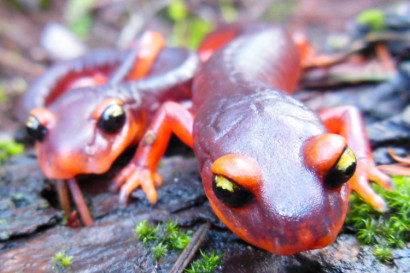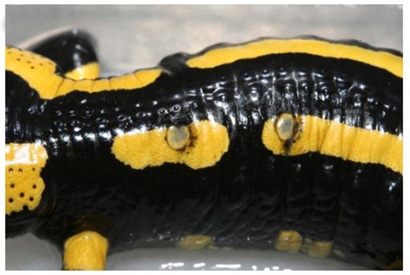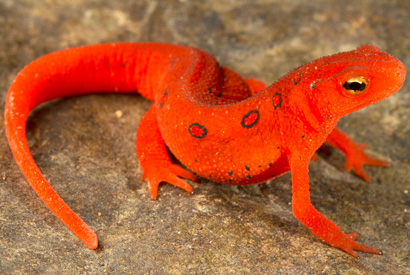Scientists Urge Ban on Salamander Imports to Fend Off New Fungus
Five California amphibian experts warn that a recently discovered fungus already devastating salamanders in Europe could imperil American salamanders, and urge the U.S. Fish and Wildlife Service to immediately halt salamander imports until there is a plan to detect and prevent the spread of the fungus.

Salamanders are an important part of forest ecosystems but also a popular pet worldwide. Nearly three quarters of a million salamanders were imported into the U.S. between 2010 and 2014, 99 percent of them from Asia, where the fungus likely originated.
Because of this, the scientists and other herpetologists worry that the fungus could spread from Asia, where the salamanders seem to tolerate the fungus, to more vulnerable parts of the globe. Since it was first recognized in 2013, the fungus has caused a 96 percent fatality rate among the European salamander species that it infected.
What makes a U.S. ban urgent is that a recent study showed that two common American salamanders – the rough-skinned newt found all over the Pacific Coast and the iconic Eastern newt of the Eastern U.S. – are highly susceptible to the fungus. The fungus, called Batrachochytrium salamandrivorans (Bsal), is related to another fungus – Batrachochytrium dendrobatidis (Bd), or chytrid – that has already severely impacted frog and salamander populations around the globe.
“This fungus is much worse than the chytrid fungus, which is more like a lingering disease that affects the skin and puts stress on the salamander until it dies,” said David Wake, a professor in the graduate school at UC Berkeley and the director and founder of AmphibiaWeb, an online database of information on amphibian biology. “Bsal is an acute infection that just turns them into little masses of slime in three to four days.”
Although a ban is supported by key scientists and the Center for Biological Diversity initiated an online petition in May to institute a ban, the federal government has been slow to act.
“There is a lot at stake here if the U.S. Fish and Wildlife Service doesn’t stop imports now to prevent the introduction of this devastating pathogen to North America,” said co-author Michelle Koo, a UC Berkeley researcher in the Museum of Vertebrate Zoology and associate director of AmphibiaWeb, an online database of information on amphibian biology.
A paper describing the potential effects of the fungus on U.S. and Mexican salamanders will appear in the July 31 issue of the journal Science.
Ports of entry

Koo and first author Tiffany Yap, a UCLA graduate student working in the museum, created a model to identify vulnerable salamander populations in Canada, the U.S. and Mexico. After pinpointing North American areas similar to the native habitat of the Asian fungus, they assessed the salamander populations in those areas and their proximity to ports of entry for the salamander trade. The model produced a map of salamander populations at highest risk of declines and extinctions from the fungus, with hotspots in the southeastern United States, particularly the southern extent of the Appalachian Mountain range and its southern neighboring region; the Pacific Northwest and the Sierra Nevada; and the central highlands of Mexico.
Through AmphibiaWeb, Koo is working with the U.S. Forest Service to create an online portal where biologists can record occurrences of Bsal infection, in order to track the spread of the fungus. Koo will discuss the Bsal vulnerability model and centralized database this week during the meeting of the Society for the Study of Amphibians and Reptiles, held July 30-Aug. 3 at the University of Kansas.
Co-author Vance Vredenburg, who has studied the chytrid or Bd fungus for more than a decade, noted that more than 200 species of amphibians have gone extinct or are near to extinction as a result of infection, making it the most devastating infectious wildlife disease ever recorded.
“I have seen the effects of Bd on frogs, to the point where I’ve seen tens of thousands of animals die in the wild in pristine areas, here in California, right in front of my eyes,” said Vredenburg, an associate professor of biology at San Francisco State University.

The new fungus, he said, “is an imminent threat, and a place where policy could have a very positive effect. We actually have a decent chance of preventing a major catastrophe.”
Salamanders are one of the most abundant vertebrate animals in many North American ecosystems and play a number of key ecological roles, Koo said.
“Because salamanders are small, often nocturnal and live underground, they are an often overlooked but integral part of the ecosystem,” she said. “They’re frequently the top predator and can make up the majority of the animal biomass of a forest. This fungus puts at risk an important part of a healthy forest.”
One of the European salamanders shown to be highly susceptible to the fungus is a member of the plethodontid family, which has its greatest biodiversity in the U.S. Nearly two-thirds of the 675 salamander species are plethodontids, including the familiar California slender salamander, and they make up the majority of salamanders in the U.S.
“California salamander populations are already way down because of the drought,” Wake said. “We need a ban now to head off this new fungus; otherwise, we will have to spend a lot of money to eradicate it.”
Richard Ambrose of UCLA is also co-author of the paper.
RELATED INFORMATION
